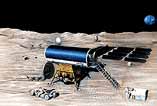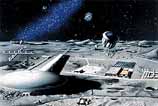Tokyo -- December 19,1996 -- Recently some 170 of the world's top space scientists, engineers and mission specialists attending the Second International Lunar Workshop in Kyoto, debating not only an extensive scientific re-exploration of the lunar landscape, but the setting up of a permanent manned presence within thirty years.
Speaker after speaker talked of the scientific and technical benefits to be accrued from exploring the moon. Some pointed to the huge tasks ahead developing critical technology needed even to get there again. But while the problem of raising finance was conveniently skipped during the five day confab, one topic dominated discussions; how to build a lunar base.
 An interim declaration proposed by Chairperson Dr. Maria Perino, an engineer with Alevia Spazio, recognized that "The establishment of a permanently human-tended lunar base is the most crucial and decisive step toward human expansion into space." Assuming the capability to get there, itself a matter of intense debate, a 50 member sub-committee spent two days wrestling with some of the thornier issues. These included what the base should be made of, when it should be built and how it should be supplied. "Fifteen years ago a lunar base seemed very exotic...now there is a growing consensus on what a lunar base might be like," said Dr. Wendell Mendell, a planetary scientist from NASA. However, aside from the barest details, while some matters were agreed on by all, other points swirled around a mire of controversy.
An interim declaration proposed by Chairperson Dr. Maria Perino, an engineer with Alevia Spazio, recognized that "The establishment of a permanently human-tended lunar base is the most crucial and decisive step toward human expansion into space." Assuming the capability to get there, itself a matter of intense debate, a 50 member sub-committee spent two days wrestling with some of the thornier issues. These included what the base should be made of, when it should be built and how it should be supplied. "Fifteen years ago a lunar base seemed very exotic...now there is a growing consensus on what a lunar base might be like," said Dr. Wendell Mendell, a planetary scientist from NASA. However, aside from the barest details, while some matters were agreed on by all, other points swirled around a mire of controversy.
 More generally, most agreed that a base would start out something like a three man "outpost" sometime between 2015 and 2030. This might develop into a 9-15 person mini-colony by 2050, depending on who you listen to. "A prefabrication system is essential," said Dr. Shinji Matsumoto, general manager, space systems division, at Shimizu Corp.. Shimizu has been cooperating with U.S. powerhouse MacDonald Douglas in formulating construction scenarios for a lunar base, in cooperation with the Construction Engineers Group for Aerospace Study, CEGAS.
More generally, most agreed that a base would start out something like a three man "outpost" sometime between 2015 and 2030. This might develop into a 9-15 person mini-colony by 2050, depending on who you listen to. "A prefabrication system is essential," said Dr. Shinji Matsumoto, general manager, space systems division, at Shimizu Corp.. Shimizu has been cooperating with U.S. powerhouse MacDonald Douglas in formulating construction scenarios for a lunar base, in cooperation with the Construction Engineers Group for Aerospace Study, CEGAS.
Shimizu had only very conceptual plans about lunar equipment, he said, but was optimistic about time scale and personnel levels. They see a 15 man permanent crew presence by 2050. Crew size would grow from four in 2010, five by 2015, eight by 2020, and ten by 2025. To do this Shimizu foresees the necessity of at least a bulldozer, crane, automated shovel and a truck.
At least the first few decades would have to advance on a "No industry-no factory" basis, he said.
But Tetsugi Yoshida, senior manager, space systems division, Shimizu Corp., said that any base would have to make use of "lunar born" materials, as the cost of transporting modules to the moon wasn't feasible.
Modest practical suggestions included the use of sandbags to build foundations and bricks to build simple tracks between different pods, all made from the lunar regolith. Fully independent robotic mining and production could also manufacture bricks to build pavement, supports, and move on to lunar glass walls and supports, though research was now at a preliminary stage, said Yoshida.
Cutting through these arguments, Dr. Willy Sadeth, professor of Space Engineering at the Colorado State University, argued that putting up a base could be relatively simple. In contrast to most assumptions that proposed a series of comparatively heavy cylindrical units, Sadeth said a base could be constructed out of relatively easily transportable 6.1 by 6.1 by 2.4 meter, 272 kg Kevlar-49 prismoidal shaped inflatable pods, costing around $16.5 million each. "Its cost is nothing compared to those other systems," he said.
 Everyone agreed that the development of autonomous intelligent robots was vital. Dr. Takashi Uchiyama, General manager, space systems laboratory, Fujitsu Laboratories Ltd. said that robot building was under intensive research by a consortium of major Japanese contractors including Kawasaki heavy industries Co. ltd., Shimizu Corp. and Toshiba Co. Ltd. The consortium calculated that it would take at least three unmanned and six manned flights to build a base. One practical step towards in-situ construction had been taken with the conception of a prototype crane robot. This would have a five meter main arm, a two meter sub-arm, be capable of ten Kph, weigh 1.4 tons. It would also be lunar night survivable as it would be able to self-deploy a "super layer insulation" cover, he said.
Everyone agreed that the development of autonomous intelligent robots was vital. Dr. Takashi Uchiyama, General manager, space systems laboratory, Fujitsu Laboratories Ltd. said that robot building was under intensive research by a consortium of major Japanese contractors including Kawasaki heavy industries Co. ltd., Shimizu Corp. and Toshiba Co. Ltd. The consortium calculated that it would take at least three unmanned and six manned flights to build a base. One practical step towards in-situ construction had been taken with the conception of a prototype crane robot. This would have a five meter main arm, a two meter sub-arm, be capable of ten Kph, weigh 1.4 tons. It would also be lunar night survivable as it would be able to self-deploy a "super layer insulation" cover, he said.
At odds with this, Japan's NASDA conceives developing at least three types of robots that would be controlled by operators on the earth. NASDA proposes 500kg single robot, twin "cooperative" 200 kg robot systems and a "parent and child" system, said Yoko Nishio. All robots could deploy solar panels, and would be driven by four to six powered wheels. They would be capable of both passive and active moon observation, exploration, surveying, sampling and analysis of the regolith, and processing of the experiments, "based on a remote operating system," she said.
 Meanwhile, scientists have practical proposals for both oxygen and food supplies, said Dr. Sanders Rosenberg, the president of In Space Propulsion Ltd. and Peter Eckart, a specialist in space engineering at Munich Technical University. Rosenberg believes a lunar rock crunching plant will be able to produce oxygen from regolith in three stages. Pointing out that humans process, in one way or another, 31 kg of supplies per day, self-sustainability was not going to be easy. However, Eckart concluded that "We have the energy to do it."
Meanwhile, scientists have practical proposals for both oxygen and food supplies, said Dr. Sanders Rosenberg, the president of In Space Propulsion Ltd. and Peter Eckart, a specialist in space engineering at Munich Technical University. Rosenberg believes a lunar rock crunching plant will be able to produce oxygen from regolith in three stages. Pointing out that humans process, in one way or another, 31 kg of supplies per day, self-sustainability was not going to be easy. However, Eckart concluded that "We have the energy to do it."After all the talking, and the concoction of a huge shopping list of needs, some members admitted that the lack of NASA and Russian participation was a big blow. While praising the Japanese for taking the lead, one contributor admitted, "If we gave $100 million to the Russians, they could do this next year." Of some 170 invited delegates, dominated by NASDA and ISAS representatives, only three were from Russia, and none of them attended the Infrastructural working group.
First published 10:22:96 -- Updated 12.19.96
Related Links
SpaceDaily
Search SpaceDaily
Subscribe To SpaceDaily Express
![]()
SPACE.WIRE |